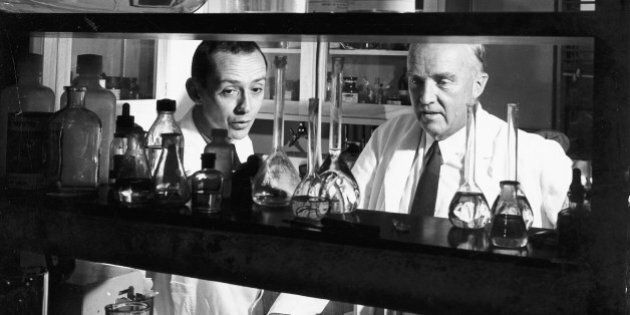
Diabetes is a disease known since ancient times. It was part of what was then called the anomalies of water vessels of the body, as described in the Ebers Papyrus. Amenhotep III, the ninth pharaoh of the Eighteenth Dynasty of Egypt who lived between 1700 and 1600 years before Christ, suffered of diabetes.
The father of Western medicine, Hippocrates, gave him the name diabetes as patients seemed always thirsty and urinate soon after drinking as if the water was passing through their body (dia - baina in Greek means "to pass through").
Diabetes and sugar
The association between diabetes and sugar was also noticed quite early in history. In one of the founding texts of Ayurveda, two famous Indian doctors of the fifth and sixth century AD, Sushruta and Chakura, said that the urine of patients with polyuria dripped like honey, was sticky to the touch and attracted ants in large numbers.
Chinese doctors made the same observation, but according to them, it was dogs that were attracted by the urine. Avicenna, a Persian physician, described two common complications of diabetes: gangrene and reduced sexual function.
Ten centuries later, the Swiss doctor von Hohenheim (1494-1541), better known as the Paracelsus, noticed that the evaporation of diabetic urine left abnormal white powder. However, he thought it was salt which, according to him, also explained the thirst of diabetics.
Finally, it was Dr. Thomas Willis (1621-1675), an eminent anatomist and British pathologist who brought again the concepts of sugar in urine after observing the taste of sugar that emanated from diabetic urines. He was the first to link diabetes with lifestyle. He said that diabetes was a rare disease in antiquity and the Middle Ages. It had become more common in his day because people ate more and consumed more wine.
The patient Dickonson
By the late eighteenth century, Mathew Dobson (1735-1784) admitted a patient named Peter Dickonson at the hospital. The 33-year-old man showed to the extreme all the symptoms of diabetes, and his volume of daily urine exceeded 15 litres (a figure that seems somewhat exaggerated, even for the time).
Nevertheless, Peter allowed Dr. Dobson to engage in a host of experiments and analysis of his blood and his urine. In 1776, the doctor published his observations in Medical Observations and Inquiries. Some of these observations highlight that there are two forms of diabetes, one in a very rapid development (Dobson shared that one of his patients died in less than five weeks) and one in chronic course.
He also noted that urine and blood plasma contained an abnormally high blood sugar, revealing the concept of hyperglycemia. With the results of this doctor, various cures appeared attempting to modify diet and daily water intake.
Anatomy and Physiology 101
Paul Langherhans, a German pathologist, discovered the existence of islets within the pancreas. As for the bonds of this body with diabetes, it is due to von Oskar Minkowski in the late 1880s. His assistant reported that a dog, from which he had removed the pancreas, woke up with a great thirst and its urine attracted flies.
In 1871, the French Apollinaire Bouchardat remarked that patients with diabetes no longer displayed glycosuria as food rationing ran rampant during the siege of Paris during the Franco-Prussian War. He speculated that it would be possible to control diabetes with proper diet food.
Then, in Toronto,
Military hero of the First World War, Frederick Grant Banting, a young doctor, began his medical practice in orthopedics in London, Ontario. During the war, in France at the Battle of Cambrai, he had come to the aid of his garrison at the risk of his own life and was injured. He was also honoured with the Military Cross for heroism.
Back home, the clientele was scarce (there was no Medicare at the time), so he accepted a position as a research assistant for a Professor Miller at the University of Western Ontario. In 1920 he was called to give a course on the pancreas.
In preparing for his lectures, the idea crossed his mind that the pancreas actually has two functions: the exocrine's secretion of gastric juices and the endocrine's production of a hormone capable of lowering the blood sugar.
From then on, Banting had only one passion: to devote all his energies to finding a cure against diabetes. He needed a laboratory and animals to do his research. Professor Macleod of the University of Toronto decided in May 1921 to provide Banting with a laboratory, 10 dogs and a research assistant, one of his most brilliant student named Charles Best.
In less than six months, Banting presented his preliminary report of research at the Physiological Journal Club of Toronto. In 1923, he, together with Professor Mcleod, received the Nobel Prize in Physiology and Medicine for the discovery of insulin.
From Discovery to Commercialization
The first insulins were handcrafted directly from the laboratories of the University of Toronto. Early on, the Eli Lilly company in the United States and Connaught in Ontario began commercial manufacturing of the product. Back then, they used pig or beef pancreases, from which insulin was extracted and purified.
In 1976, the methods would change dramatically. A young American company revolutionized the production of insulin by biotechnology. By modifying the DNA of certain microorganisms and by grafting the genes encoding for the synthesis of insulin in humans pancreas, it was possible to synthesize human insulin rapidly and effectively.
Genentech saw its shares climb more than any other company, inaugurating a new era in drug manufacturing.
The arrival of insulin has played a major role in improving both the longevity and quality of life for diabetics: In the mid-twentieth century, the life expectancy of diabetics was not very good. Most could not expect to live beyond 40 or 50 years. Today, the life expectancy of type 1 diabetes is shortened by 10 years compared to the general population.
Although it has considerably extended, as evidenced by the study Pittsburgh Epidemiology of Diabetes Complications: between the 1950-1964 period and the 1965-1980 period, mortality at 30 years decreased from 36 per cent to 12 per cent.
At the symposium, an 86-year-old patient, Kathryn Ham, testified and spoke of her past 78 years with type 1 diabetes. In conclusion, Professor Pierre Gourdy, endocrinologist at the University Hospital of Toulouse (Haute-Garonne) said: "The data are very encouraging, particularly the reduction of the occurrence of various complications."
Follow HuffPost Canada Blogs on Facebook
MORE ON HUFFPOST:
